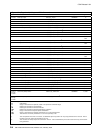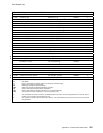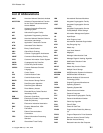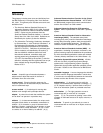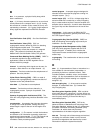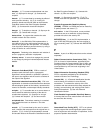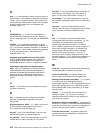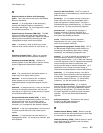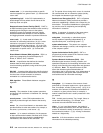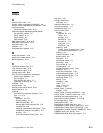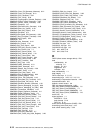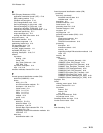CCA Release 2.54
H
host. (1) In this publication, same as host computer or
host processor. The machine in which the Coprocessor
resides. (2) In a computer network, the computer that
usually performs network-control functions and provides
end-users with services such as computation and
database access. (T)
I
IMPORTER key. (1) In the CCA implementation, a
type of DES Key-Encrypting Key that can decipher a
key at a receiving mode. (2) Contrast with EXPORTER
key.
initialize. (1) In programming languages, to give a
value to a data object at the beginning of its lifetime. (I)
(2) To set counters, switches, addresses, or contents of
storage to zero or other starting values at the beginning
of, or at prescribed points in, the operation of a
computer routine. (A)
Integrated Cryptographic Service Facility (ICSF).
ICSF is an IBM licensed program that supports the
cryptographic hardware feature for the high-end
System/390 processor running in an MVS environment.
International Organization for Standardization
(ISO). ISO is an organization of national standards
bodies established to promote the development of
standards to facilitate the international exchange of
goods and services, and develop cooperation in
intellectual, scientific, technological, and economic
activity.
J
jumper. A wire that joins two unconnected circuits on
a printed circuit board.
K
key. In computer security, a sequence of symbols
used with a cryptographic algorithm to encrypt or
decrypt data.
Key-Encrypting Key (KEK). (1) A KEK is a key used
for the encryption and decryption of other keys.
(2) Contrast with data-encrypting key.
key half. In the CCA implementation, one of the two
DES keys that make up a double-length key.
key identifier. In the CCA implementation, a 64-byte
variable which is either a key label or a key token.
key label. In the CCA implementation, an identifier of
a key-record in key storage. See “Key Labels” on
page 5-14 and “Key-Label Content” on page 7-2.
key storage. In the CCA implementation, a data file
that contains cryptographic keys which are accessed by
key label.
key token. In the CCA implementation, a data
structure that can contain a cryptographic key, a control
vector, and other information related to the key.
L
link. (1) The logical connection between nodes
including the end-to-end control procedures. (2) The
combination of physical media, protocols, and
programming that connects devices on a network.
(3) In computer programming, the part of a program, in
some cases a single instruction or an address, that
passes control and parameters between separate
portions of the computer program. (A) (I) (4) To
interconnect items of data or portions of one or more
computer programs. (T) (5) In SNA, the combination of
the link connection and link stations joining network
nodes.
M
make file. A composite file that contains either device
configuration data or individual user profiles.
master key (MK, KM). In computer security, the
top-level key in a hierarchy of key-encrypting keys.
Message Authentication Code (MAC). (1) A number
or value derived by processing data with an
authentication algorithm, (2) The cryptographic result of
block cipher operations on text or data using a cipher
block chaining (CBC) mode of operation, (3) A digital
signature code.
migrate. (1) To move data from one hierarchy of
storage to another. (2) To move to a changed
operating environment, usually to a new release or a
new version of a system.
Modification Detection Code (MDC). In cryptography,
the MDC is a number or value that interrelates all bits of
a data stream so that, when enciphered, modification of
any bit in the data stream results in a new MDC.
multi-user environment. A computer system that
provides terminals and keyboards for more than one
user at the same time.
X-6 IBM 4758 CCA Basic Services, Release 2.54, February 2005



